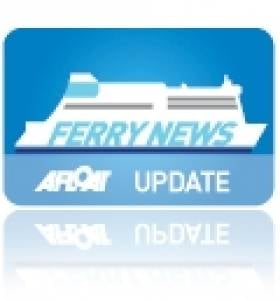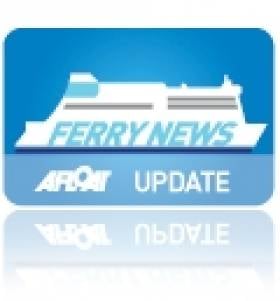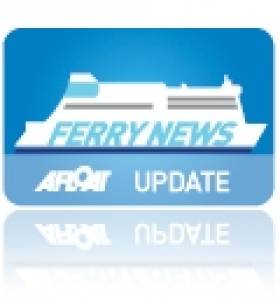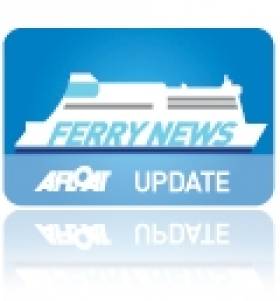Displaying items by tag: Stena Line
Strong Winds Cancel Central Corridor Fast-Ferry Sailings
Stena Line's Dublin-Holyhead sailings are on schedule in addition to services on the Rosslare-Fishguard, Belfast-Stranraer (incl. HSS sailings) and Belfast-Liverpool. P&O's Dublin-Liverpool and North Channel Larne-Cairnryan route are also on schedule.
On the Celtic Sea, Fastnet Line's Cork-Swansea is unaffected as there are no sailings on Monday's, Tuesday's and Wednesday's during this month and November. The next sailing is this Thursday from Cork at 20.30hrs and returning Swansea on Friday at 21.30hrs.
According to Met Eireann, this afternoon will be extremely windy, especially across the southern half of the country, with southwest gusts of between 90 and 120km/h. For more detailed and updated weather forecasts visit www.met.ie
Stena 'Superfast' Ferries to Get the Nordic Spa Treatment
Apart from the novelty factor of this on board feature the 30,285grt vessels will also the largest ever deployed on any North Channel route. In addition the region will see the opening of the new £80m ferryport of Loch Ryan Port, located close to rivals, P&O (Irish Sea) at their terminal in Cairnryan.
Stena's decision to relocate to Loch Ryan Port which is only eight miles away from its existing Scottish terminal in Stranraer on the shores of Loch Ryan is to reduce passage times, fuel costs and road travel times. The closure of this port will also see the end of HSS fast-craft sailings served by HSS Stena Voyager and conventional vessels Stena Caledonia and Stena Navigator.
The Superfast sisters are on charter for two-years, where they will operated the new 2 hour 15 minute route which is due to be launched on 21 November. They will make 12 crossings per day and each of the ten-deck ships can carry up to 1200 passengers, 660 cars or 110 freight units.
Originally the pair, built in 2001 at the Howaldtswerde Deutsche Werft AG, Kiel for Attica Enterprises, were used by Superfast Ferries on their German (Rostock-Hanko) Finnish route. In 2006 they were sold to Tallink, where they operated on other Scandinavian services.
P&O Close Seasonally Operated Fast-Ferry Services
As for the remaining winter-serving fast-ferries they are Stena Line's HSS Stena Voyager (1996/ 19,638grt) between Belfast-Stranraer, in tandem with conventional ferries. Next month this route will close as the Scottish terminal relocates to a new ferryport nearby at (Loch Ryan Port) Cairnryan.
In addition two sister-ferries, which are undergoing modifications and an upgrade for their two-year charter on the North Channel, will directly replace the two-hour passage times it takes for the HSS fast-ferry and the ferries Stena Caledonia and Stena Navigator which take 2hrs 50 minutes.
With the introduction of the new tonnage to the Belfast-Cairnryan route, sailings times will be reduced to 2hrs 15mins. Ironically the new ferries which albeit will be the largest to serve on any North Channel route will actually be some 15 minutes slower on the newer-shorter distance route compared to the HSS fast-ferry operated Belfast-Stranraer sailings.
The second fast-ferry service is operated on Irish Ferries Dublin-Holyhead route using Jonathan Swift (1999/5,989grt) which is marketed as the Dublin 'Swift'. She runs year-round in addition to the cruiseferry Ulysses.
Also operating fast-ferry craft is the Isle of Man Steam Packet Company's Manannan (1998/5,029grt) but this is on the none cross-channel route between Douglas and Liverpool.
Irish Sea Cross Channel Fast-Ferry Services On Declining Trend
The third service between Belfast-Stranraer is in the hands of rivals Stena Line which maintain the HSS Stena Voyager (1996/19,638 grt) on sailings but only to around mid-November. She will be replaced by conventional sister-ships which will be introduced on the North Channel's newest port when services switch from Stranraer to a new terminal close to Cairnryan.
Finally the fourth fast-ferry is Irish Ferries marketed 'Dublin Swift' service which runs on the Dublin-Holyhead route served by Jonathan Swift (1999/5,989 grt). The craft built by Austal in Fremantle, operates alongside the conventional cruise-ferry Ulysses.
Stena Line's decision to terminate HSS Stena Explorer sailings between Dun Laoghaire-Holyhead this day last week follows fast-ferry Stena Lynx III's end-of-season Rosslare-Fishguard sailings earlier this month.
From next year, Dun Laoghaire-Holyhead sailings are to be seasonal-only and according to Stena Line they hope to resume fast-ferry sailings in April or May though no exact date has been set. Unlike the central corridor route which was entirely dependent on HSS operations, the Rosslare-Fishguard route remains operating year-round with the conventional ferry Stena Europe.
As a result of the discontinued fast-ferries, the HSS Stena Explorer is now spending a lay-up period in the Welsh port for the winter. The smaller Stena Lynx III is also 'wintering' but in on the opposite side of the Irish Sea in Dun Laoghaire, where the vessel has done so in previous years.
The lay-up of both fast-ferries in Dun Laoghaire and Holyhead is ironic considering that neither ports' are connected by the very craft that used to share sailing rosters in recent years. In addition the wintering of these catamaran craft is the first time that this has occurred since the pioneering Stena Sea Lynx fast-ferry launched such sailings in 1993.
This first 'Lynx' provided seasonal sailings on the route with conventional car-ferry Stena Hibernia, the former St. Columba, custom-built in 1977 for Sealink /British Rail. She was given a second name under Stena ownership, the Stena Adventurer and remained on the 57 nautical-mile route until replaced in 1996 by the year-round operated HSS Stena Explorer.
Apart from cross-channel fast-ferry services, the Isle of Man is served by the Isle of Man Steam Packet Co. Ltd's routes linking the islands capital Douglas with Belfast, Dublin, Heysham and Liverpool (Birkenhead) in the winter. These routes include seasonal services which are operated by a combination of conventional tonnage using Ben-My-Chree and fast-ferry Manannan (1998/5,089grt), a former US Navy vessel, to read more click HERE. For sailing schedules, vessel type deployed on route and for fares click HERE.
- Dublin Port
- Irish Ferries
- Dun Laoghaire
- Stena Europe
- Holyhead
- P&O Ferries
- Belfast Harbour
- Stena Line
- Larne
- Ports and Shipping News
- Ulysses
- P&O (Irish Sea)
- Cairnryan
- Ferry news
- Stena Explorer
- Stena Express
- FastFerries
- Cruiseferry
- Manannan
- Isle of Man Steam Packet Co.
- Stena Voyager
- Belast Port
- Isle of Man ferry services
- P&O Express
- Irish Sea fastferries
- Stena 'Lynx'
- BenMyChree
- Dublin Swift
- Stena Sea Lynx
Dun Laoghaire-Holyhead (HSS) High Speed Sailings Close
The core reason to withdraw the HSS on the 120-minute route which is not to re-open until the 2012 season, rests with the high operating costs of the fuel-thirsty fast-ferry which is powered by four gas-turbine engines. In addition the route's generated most of its turnover during the period May-September, leaving the remaining months unsustainable, as such the company wants the route to be seasonal-only in the long-term.

HSS Stena Explorer departs Dun Laoghaire Harbour on her final sailing this season. Photo: Jehan Ashmore
Passengers and freight customers will instead need to use the company's other Dublin Bay route between Dublin Port and Holyhead. The 3 hour 15-minute central corridor route is served by two ro-pax vessels, Stena Adventurer (2004/43,532 grt) and Stena Nordica (2000/24,206 grt) which operate to a year-round schedule, for times click HERE.
What is not certain is the precise date for resumption of Dun Laoghaire-Holyhead services as Stena Line have only indicated that they hope to reopen in April or May nor it is outlined as to what type of fast-craft would operate the route next year.
With today's break in service for at least the next six months, this is the most significant absence of the revolutionary HSS (High Speed Sea Service) 1500 fast-ferry which made her official maiden voyage on the route from Dun Laoghaire on 10th April 1996. The only other notable occasions when the HSS was off-service was for the short spells to allow for annual dry-docking, refit, repairs or when the route in recent years was partially operated by Stena Lynx III.
The 1500 referred to the number of passengers the Stena Explorer could accommodate. She was the first of the three Finish-built HSS 1500 catamaran vehicle capable carrying craft to enter service on three routes from the UK. The next sister completed HSS Stena Discovery entered service in the same year between Harwich-Hook van Holland and the final of the trio HSS Stena Voyager entered the Belfast-Stranraer route in 1997. Several years ago the HSS ceased operating on the Dutch route and the HSS currently serving on the North Channel is due to be replaced by conventional ferries in mid-November as previously reported on Afloat.ie, to read more click HERE.
On the Dun Laoghaire-Holyhead service the HSS enjoyed the boom years, and at its peak there were five daily round trips. From 2006 onwards the routes fortunes began to decline due to the ending of duty-free sales, competition from low-cost airlines, and the increasing cost of fuel.
In order to stave off further losses, a series of cost cutting measures were implemented over the next five years. Firstly the sailing frequency was reduced then the passage times were increased to reduce fuel consumption at the expense of faster crossings. In addition the company resorted to withdrawing the Stena Explorer during the shoulder months surrounding the summer and as previously mentioned these sailings were covered by the Stena Lynx III.
When the Stena Explorer returned for the summer months, the Stena Lynx III switched to her normal high-season spell on Rosslare-Fishguard sailings in tandem with regular route vessel Stena Europe. This year she served as usual on the St. Georges Channel route with the last high-season sailing completed on 4 September.
Stena Lynx III remained initially at Fishguard until making a repositioning voyage to Dun Laoghaire via the Kish Lighthouse last Wednesday. She berthed adjacent to the now disused HSS berth link-span on St. Michaels Wharf. The Tasmanian built craft has spent previous winter layover periods in Dublin and last year in Dun Laoghaire whereas the Stena Explorer is expected to do so in her home port of Holyhead.
At the neighbouring Carlisle Pier, the former terminal where numerous steam-packets, 'mailboats' and the conventional Sealink/British Rail car-ferries served (the last being the Stena Adventurer better known as St. Columba built in 1977) there are plans for a national diaspora museum.
The centrepiece landmark building would form as part of the masterplan proposed by the Dun Laoghaire Harbour Company as part of a concerted effort to offset the reduced role of ferry operations. The masterplan is also to attract cruiseship business amongst other proposals envisaged.
- Dublin Port
- Dun Laoghaire Harbour Company
- Cruise Liners
- HSS Stena Explorer
- Dun LaoghaireHolyhead
- Stena Lynx III
- Stena Line
- Port of Dublin
- Ports and Shipping News
- Ferry news
- Stena Explorer
- HSS
- St.Michaels Wharf
- Dun Laoghaire Harbour News
- Stena Adventurer
- Irish Sea ferry news
- Cruise ships
- Carlisle Pier Dun Laoghaire
- Stena Nordica
- Closure of HSS sailings
- HSS (High Speed Sea Service)
- Dun Laoghaire masterplan
- Diaspora Museum Dun Laoghaire
Bon Voyage to Stena Voyager
The Stena Voyager high-speed ferry will make its final crossing between Belfast and Stranraer in mid-November.
BBC News cites the high cost of running the service, as well as its limited freight capacity, as reasons for the mothballing of the Stena HSS (High Speed Service).
The world's biggest high-speed ferry was a revelation when it was launched in 1996. The catamaran could reach speeds of up to 40 knots powered by enormous gas turbine engines.
But the rising cost of oil prompted a reduction in the ferry's cruising speed to save costs, making room for competition from conventional ferry routes with larger freight capacities.
The Voyager's fate was sealed when Stena Line announced plans to move its Stranraer port to a new location that will shave 20 minutes off the crossing for the two new but standard ferries that will replace it.
As previously reported on Afloat.ie, the Stena HSS between Dun Laoghaire and Holyhead will also be suspended from later this month, though it is planned to resume service in 2012 for the summer season.
Stena Line to Reduce Dun Laoghaire-Holyhead Service
Stena Line said the fast craft service would operate until 13th September and would then be suspended until the 2012 season. Two conventional ferries will continue to operate year-round on the company's neighbouring route between Dublin Port and Holyhead.
Stena said it hoped to start the service again in April or May although no decision has been made on an exact date.
Area Director for Stena Line's business on the Irish Sea Michael McGrath said: "Despite all our attempts to reduce operating costs over the last few years, it has not been possible to return the route to profitability.
"We regret that this decision will have an impact amongst our ship's personnel and our port operations staff in Dun Laoghaire but this is a decision that has to be taken for the benefit of the overall business. We simply cannot continue to sustain these levels of financial losses.
"We will now embark on a period of consultation with our staff and their union representatives to discuss the implications of the proposed changes with them."
Stena says it hope to start the service again in April or May, although no decision has been made on an exact date. It is believed around 53 staff will be affected by the decision.
Dundalk Dredger Docked in Dublin Port Is Up for Sale
The Dublin Port Company has sought expressions from interested parties in undertaking the remaining activities of the port on an exclusive basis.
The Dundalk registered dredger arrived to the capital port on 14 July where she remains berthed at the Bulk Jetty in Alexandra Basin. Her previous owners, the Dundalk Port Company were unique in that they were the only port company to own and operate a dredger in the Republic. For many years the 757-tonnes dredger has carried out numerous contract assignments in ports throughout the island of Ireland including work on the Samuel Beckett swing-bridge and the most project was at Queens Quay, Belfast on the Lagan close to the city-centre.
Hebble Sand was launched by Richard (Shipbuilders) of Lowestoft for British Dredging and later used by Associated British Ports to serve a network of UK ports. Despite her age, the near fifty-year-old veteran vessel has been kept in excellent condition and this was evident during a rather unusual appearance for a ship of her type when attending the Dublin Docklands Maritime Festival in 2009.
She was made open for the public amongst the tall-ships that lined the Liffey Quays. Such an initiative was inspiring as it provided a rare opportunity for the public to access such a dredger which otherwise is not familiar compared to the popularity of visiting tall-ships and naval vessels.
The only other port to operate their own dredger is Londonderry Harbour Commissioners, whose Lough Foyle has worked on projects outside her homeport. This has included work at the new £40m Stena Line ferryport terminal on Loch Ryan close to Cairnryan and is due to open in November.
- Dublin Port
- Dublin Port Company
- Dundalk Port Company
- Stena Line
- Port of Dublin
- Ports and Shipping News
- Alexandra Basin
- Ferry news
- Dundalk Port
- Samuel Beckett Bridge
- Dredger Hebble Sand
- Dredger Lough Foyle
- Londonderry Harbour Commissioners
- Samuel Beckett SwingBridge
- Cairnryan ferryport
- Loch Ryan ferry terminal
- Associated British Ports
- ABP
- Richards Shipyard
- Queens Quay Belfast
- Dublin Docklands Maritime Festival 2009
Sponsorships of Ice-Sea Giants
Stena Line themselves will be looking forward to introducing their own giants when two of the largest ferries are to be introduced on the North Channel in the Autumn. The two chartered 30,000grt sisterships are Superfast VII and Superfast VIII. To see the vessel breaking through an an ice-flow, click PHOTO. The 203m long pair can take 1,200 passengers, around 660 cars or 110 freight vehicles. To read more about these 'Superfast' class vessels and the new £80 port terminal click HERE.
The company's area director Michael McGrath said: "It's quite fitting that we are teaming up with the Stena Line Belfast Giants at this time as we prepare to introduce two of the largest ferries every to sail between Northern Ireland and Scotland when we open our new route and port in Cairnryan this November. The two Superfast vessels will be another two Giants to add to our team."
Last year Stena Line made a £40m acquisition of the Belfast to Liverpool (Birkenhead) and Heysham routes and four vessels from DFDS Seaways. The deal was approved by the Irish authorities but remained subject to clearance from the UK's Competition Commission until late last month when they fully approved the acquisition.
This brings to six routes the company runs on its Irish Sea route network where over two million passengers were carried each year, more than its rival ferry operators combined.
- DFDS Seaways
- Belfast Harbour
- Stena Line
- North Channel
- Competition Commission
- BelfastHeysham
- Superfast VII
- Superfast VIII
- Belfast Lough News
- Belfast Port
- Odyssey Arena
- Belfast Giants
- BelfastCairnryan
- New ferryport
- Nottingham Panthers
- Sheffield Steelers
- Hockey Festival Weekend
- BelfastLiverpool (Birkenhead)
- Irish Sea ferry companies
- Irish icehockey
Prior to her arrival on the North Channel, Norcape had been laid-up in Liverpool since February 2010 after the former B+I Line vessel (MV Tipperary) was replaced by European Endeavour on the central corridor route to Dublin. As of this week the ro-pax freight vessel which has been running in a freight-only mode will now carry motorists likewise to her route fleetmates Norbank and Norbay.
With the departure of European Mariner from the Irish Sea, she follows a trio of former Stena Line freight-ferry sisters which were made redundant since the closure of the Belfast-Heysham route late last year. It is believed the sisters Stena Seafarer, Stena Leader and Stena Pioneer have been sold to Russian interests to serve in the Black Sea in connection to the 2014 Winter Olympics in Sochi.
The sisters were renamed, Stena Pioneer became Ant 1, Stena Seafarer is the Ant 2 and Stena Leader is the Anna Marine. They departed Belfast Lough in mid-June to Sevastopol in the Ukraine under the Moldovan flag and with a port of registry in Giurgiulesti.
- Port of Larne
- Belfast Lough
- Stena Line
- Ports and Shipping News
- RoPax
- North Channel
- P&O (Irish Sea)
- B+I Line
- European Endeavour
- Ferry news
- Belfast Lough News
- RosslareFishguard
- LarneTroon
- European Mariner
- Freightferries
- MV Tipperary
- Central Coridoor route
- BelfastFleetwood
- Stena Europe ferry
- 2014 Winter Olympics
- Sochi
- Black Sea
- Turkish shipbreakers
- Izmir
- Turkey
- Winter Olympics 2014
- Irish Sea ferry motorists








































































